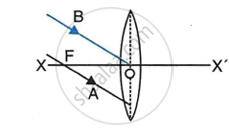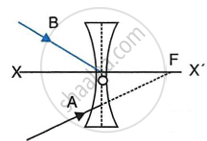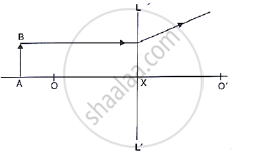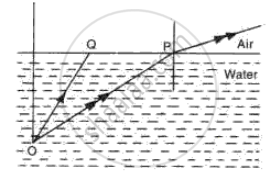Advertisements
Advertisements
प्रश्न
Make the rrect choices in the following items :
An object is placed 50 cm from a connverging lens of focal length 30 cm. The image produced would be
विकल्प
lnverted and same size as the obíect
lnverted and diminished
lnverted and magnified
Erect and diminished
Erect and magnified
उत्तर
lnverted and magnified
APPEARS IN
संबंधित प्रश्न
State the condition when a lens is called an equi-convex or equi-concave.
In the diagram below, XX’ represents the principal axis, O the optical centre and F the focus of the lens. Complete the path of rays A and B as they emerge out of the lens.
 |
 |
| (a) | (b) |
Distinguish between a real and a virtual image.
Study the diagram shown in Fig. 5.56
Where is the image formed?

A ray of light incident at the optical centre of lens, passes undeviated after refraction.
(a) Draw a sketch to show how a lens is able to produce an image of the sun on a paper screen.
(b)(i) Would you regard the rays from the sun as being divergent, parallel or convergent?
(ii) What is the name given to the point where such rays meet after they have passed through the lens?
(iii) How does the image of the sun sometimes burn a paper screen?
Make the correct choices in the following items:
lf the image can be focused on a screen it must be
Fig. shows two rays of light Op and OQ coming from an object at the bottom of a pond, incident on the water surface.

(a) Mark on the diagram
(i) The angle of incidence of ray OP,
(ii) The angle of refraction of ray Op,
(iii) The position of image of the object as seen from above.
(iv) An approximate path of the ray OQ.
(b) Explain, why do the rays of light change directions on passing from water to air.
(c) A fish in water sees everything outside the water by rays of light entering its eye in a small cone of light. Draw a diagram and explain how does this happen.
State the nature and position of the object on the principal axis to obtain a real and magnified image.
Complete the following diagram and state what happens to the ray of light after refraction through the lens.

